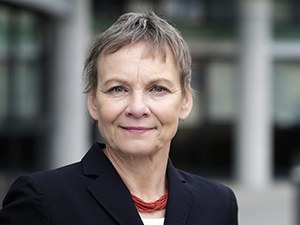The road to freedom in research and teaching

Prof. Dr.-Ing. Dr. Sabine Kunst,
Photo: Matthias Heyde
The 3rd of October and the German reunification are of very special importance for the Humboldt-Universität zu Berlin. Our university has witnessed many historic turning points over the course of its 200-year history. Among the more felicitous of these, but also the most challenging, are the political transformation in the GDR and the German reunification.
Article 38 of the Unification Treaty outlined the mission to create an all-German research and development landscape. The goal: an academic system at the level of universities and non-university institutions in the old federal territory. The direction and framework were thereby provided, and these stipulations also had implications and consequences for the flagship GDR university in the heart of Berlin.
Back in July 1990, the Council of Science and Humanities passed twelve recommendations that formed an important basis for the design of the East German academic system. As a result, all East German universities essentially reinvented themselves. Institutions were also refounded, like in Erfurt, or newly founded, like in Brandenburg. The universities of applied sciences, which – unlike in West Germany – were assigned research as a mandate by law, experienced a very promising new start. The numerous new non-university institutes of the Max Planck and Fraunhofer Societies or the Helmholtz and Leibniz Associations also had a transformative effect. The institutes of the Academy of Sciences of the GDR were closed or subsumed into these structures.
During this time, as a research assistant for the Federal Environment Agency, I travelled a lot within the triangle of Hanover, Berlin and Hamburg and had intensive contact with water management specialists, especially in Dresden and Magdeburg. Even after 1990, there were lots of peer consultations concerning water supply and disposal practitioners in the new federal states. I still to this day have great admiration for the great commitment, the bold talent for improvisation, and the tremendous progress of the East German universities. Yet the fears and disappointments that accompanied the process of change in the academic institutions are also not forgotten. To this day, I regret that many extraordinarily original and unique ideas and approaches were not carried forward and pursued, and simply found no place within the system of the all-German academic landscape.
A mélange of fears and euphoria
At the time, I followed the events at the Humboldt more or less from a distance. Every now and then, they were the subject of conversations between colleagues, but also, of course, in the media.
Most people probably remember these important months and years as a time of new departures and farewell. As a breathless time in which new structures were built in a matter of a few months and with incredible commitment. A time of democratisation and enlightenment – but also a confrontational time in which much was only viewed within the context of a black and white debate, in the unnuanced juxtaposition of good and evil, with little room for differentiation and ugly debates that left wounds that have not healed to this day. In this context, we should remember the personal and professional reviews that all staff underwent in the early 1990s. Both led to a serious change in the personnel structure and also to painful staff cutbacks. These evaluation processes led many Humboldtians into a new future, but, for many others, they signified the end of their academic careers or a move into other areas.
In the years that followed, despite all the difficulties that the transformation processes brought with them, the university developed into one with an excellent reputation, both nationally and internationally. Outstanding scientists from the East and West, Germany and abroad, contribute to this. Overall, the reunification of the Humboldt-Universität led to an enormous leap in the strength of its research and the quality of its courses. Everything that made new networks possible played a large part in this, for example, the German Research Foundation (DFG). Conferences and trips financed by the DFG promoted networks, contact and exchange between researchers in East and West Germany. This quickly led to research collaborations that enormously enrich the innovative strength of our university.
Transition and change
I have now been living and working in Brandenburg and Berlin for 15 years and have been president of this university for almost five years. We are still undergoing change today. How could it be otherwise at such an outstanding site of research and teaching as the Humboldt? The way in which transition and change are lived here still shows the will to make new departures, just like 30 years ago. At the Humboldt-Universität, stagnation in research and teaching is unacceptable. Then as now, this university grows and lives in change. It is ready for this and is taking the necessary steps to reorient itself.
Sabine Kunst
President of the Humboldt-Universität zu Berlin
